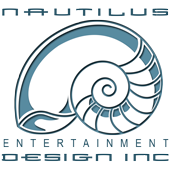2021
Nautilus Entertainment Design, Inc. Becomes An Employee-Owned Business
San Diego, CA, February 2, 2021 – Nautilus Entertainment Design, Inc. (NED) announced today that after 30 years in business, the company founders Laura and Jim Tetlow, are selling their stock to the company ESOP (Employee Stock Ownership Plan.) With this sale, the company will become 100% employee-owned. Jim Tetlow will continue on in a consultancy role as Principal Consultant and Lighting Designer for select shows and projects in an effort to provide NED’s clients with a multi-year seamless transition.
Jim Tetlow comments, “When we started the business 30 years ago, our focus was on lighting design for TV and live events. At that time it never occurred to us that we would expand into so many more disciplines including architectural lighting design, A/V system design, and theatre consulting. One of our proudest achievements is the fact that we have built a team of professionals that excel in their work across live events, cruise ships, architectural installations and themed entertainment.
Continuing in their leadership roles with NED are Principal Consultants Bill Havens and Brian Pratt, both of whom will assume the responsibilities of Managing Directors. Bill Havens has been with NED for 20 years. He has served as Project Manager delivering entertainment spaces for dozens of cruise ships in the Carnival Corporation family including Cunard Line, Holland America Line, Princess Cruises and the ultra-luxury Seabourn. Prior to joining NED, Bill spent fifteen years working in project management in the live event and television business in and around New York City. Brian Pratt started with NED in 2008 and has served as a Project Manager for Costa Cruise Lines and Director of Design overseeing many projects both on land and sea. Before starting with NED, Brian worked in production for theatre, television, and live events in the states and abroad.
Joanna Rodriguez, Vice President of Business Operations will serve as Chief Financial Officer and came to NED three years ago from Bank of America.
Jim Tetlow states, “Laura and I are excited about this new chapter in the life of the company and we are confident that moving forward, Bill, Brian and Joanna’s roles will provide the continuity and leadership for Nautilus to continue to thrive and grow.”
Since 1990, NED has provided lighting design, theatre consulting, and A/V system design for projects worldwide, with specific expertise in cruise ships, themed entertainment, and live special events. Based in San Diego, NED employs over 20 professionals including theater consultants, lighting and A/V designers and project managers.
2020
Seduced by Technology Again and Again – with Jim Tetlow: PODCAST
On this episode, Chris Lose discusses Jim’s varied career from drama school to TV lighting to Las Vegas shows to cruise ships and Branson to architectural lighting and theme parks, the necessity of reinventing ourselves several times during our career, the importance of learning all aspects of our industry, why we need to know what the other departments are doing, when it’s time to move on to bigger and better, when to say yes to multiple opportunities, enhancing opportunities and the benefits of having a supportive team and partner.
Thought Leader Of The Week: Jim Tetlow, Nautilus Entertainment Design
LiveDesign, article by Ellen Lampert-Greaux • May 12, 2020
President and principal consultant at Nautilus Entertainment Design, Jim Tetlow has been negotiating the shutdown of the events and entertainment industry with aplomb. From cruise ship technical systems to theme parks by way of theatre consulting and lighting design, his company thrives on diversification, a strategy that has proved especially savvy in recent months. Live Design chats with Tetlow on his background, current projects, and the future in the age of COVID-19.
Live Design: Can you talk a little about Nautilus and how the company was started and developed?
Jim Tetlow: I graduated from CMU in the late ’70s and went into television lighting, where I spent all of the 1980s with Imero Fiorentino Associates, first in NY and then in L.A. Although most of my work was in television, the company was diversified; this is where I did my first corporate shows, and was exposed to architectural lighting and facility design. My wife and I started our company in 1990, while we were living in Los Angeles. In 1991, I had a show running at the Stardust in Las Vegas and some executives from Carnival Cruise Lines saw it, and called me the next morning to see if I’d light some of the shows on their ships. That led to theatre consulting on Carnival Destiny in 1996, which also included the lighting, rigging, and special effects systems. After that project…
2019
NAIAS 2019 in Detroit – A Look at GM’s Booths, Lit by Nautilus Entertainment Design
PLSN, by Michael S. Eddy • in February 2019 Focus on Design Created: February 11, 2019
Detroit has hosted an auto show since 1907, becoming the North American International Auto Show (NAIAS), a truly international event, 31 years ago. One of the most influential annual automotive events in the world for the industry, NAIAS serves as a global stage for companies to debut vehicles and make industry-shaping announcements. The attention required for every detail of their booths is a top priority to the automotive brands on the floor to effectively display the cars and the brands themselves.
This year’s NAIAS events kicked off with press previews on Jan. 14 and 15, with the public show running from then until Jan. 27. The booth builds themselves start in late fall each year, continuing through to the opening.
2018
Nautilus Entertainment Design part of winning team for “Best Stage Experience” of the 2018 Experience Design & Technology Awards
San Diego, November 27, 2018 –Nautilus Entertainment Design is proud to have been a part of the team awarded the Gold Winner for the “Best Stage Experience” at the 2018 Experience Design & Technology Awards. The winning project was the 2018 CES Keynote, produced by Clarity Creative Group and John Halloran + Associates for their client Intel. These awards recognize the best use of design, social media and event technology to enhance live experiences.
Nautilus Entertainment Design (NED), a 28 year old design company located in San Diego, was charged with not only the design and programing of the production lighting, but also with coordinating the installation of the wireless data points that created a virtual GPS network inside the theatre.
The theme of the show was “Experience the Power of Data.” Data drove not only lights and video, but also many of the “moving parts” of the show from a mini-drone show, a self-driving car, to a drone helicopter, and 248 Tait Nano Winches with custom LED fixtures. Twenty-four of those fixtures also were tracked laser targets and four of them had laser emitters. The center part of the 200 foot wide stage floor was a 72’ x 46’ LED video screen, which seamlessly joined an LED wall that functioned as the primary background. Nautilus Principal Jim Tetlow said, “Because of a very short installation time, John Halloran booked the Cow Palace in San Francisco for two weeks in December, so that all of the technology could be tested and rehearsed.”
Click to read entire article at PLSN
2017
Holland America Line Outfits Cruise ships with DiGiCo
Nautilus Entertainment Design adds SD-Series consoles to performance spaces for events ranging from intimate events to arena-level concerts.
ProSound Web by PSW Staff, Dec. 8, 2017
When a venue has just two performance spaces in which to schedule everything from intimate events to Broadway shows and arena-level concerts, that venue needs to know its audio console is utterly reliable and able to switch applications on a dime. When that venue is a thousand miles out on the high seas for those shows, the need for reliability and functionality are increased by several orders of magnitude.To ensure the needed reliability, San Diego-based Nautilus Entertainment Design (NED) has placed DiGiCo SD-Series consoles aboard much of the Holland America Line’s fleet in recent years, with more to come.
“If you need a capsule for your wireless microphone, you’re not going to be able to quickly run downtown and buy one,” says Alan Edwards, principal audio design consultant for NED.
READ the entire article…
For Immediate Release
July 23, 2017
Nate Hall, In Memoriam
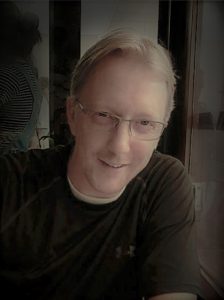 San Diego, CA July 23–Nathaniel (Nate) Hall, passed away unexpectedly Monday, July 17, 2017. He was 36.
San Diego, CA July 23–Nathaniel (Nate) Hall, passed away unexpectedly Monday, July 17, 2017. He was 36.
Nate, Manager of Design for Nautilus Entertainment Design, came to the company after spending 15 years in the contracting and live entertainment fields. After receiving his BFA from University of North Carolina School of the Arts, he was the lead sound designer and assistant technical director for a liberal arts university in Elon, NC and continued to work shows around the southern United States. He moved to San Diego in 2004 where he became a lead project engineer for a top 50 systems integrator. He has been featured in FOH magazine for his system design and installation of the audio system at the Gila River Arena and was published along with a colleague in ITAV magazine for his extensive work in networking for AV.
At Nautilus, Nate worked on cruise ship projects for Seabourn, Costa Asia, and Carnival, a theatre consultation for St. Augustine’s High School, and most recently, the Harry Potter Nighttime Lights show at Universal Studios Hollywood.
Nate was pursuing a post-graduate engineering degree in acoustics from Pennsylvania State University at the time of his death.
Jim Tetlow, President of Nautilus Entertainment Design stated, “Although Nate had only been with us for a year, he was an important member of our team and on the fast track for a key management position in the company. We will miss his knowledge, perseverance, people skills and great attitude.”
Nate is survived by his mother and father, Norine and Mark Hall and brother, Matt.
2014
PITTSBURGH, PA Oct. 16–Carnegie Mellon University Alumni Association selected W. James Tetlow (College of Fine Arts ’77) to receive one of this year’s Alumni Achievement awards. The ceremony took place on Friday Oct. 10th in Kresge Theatre and Great Hall in the College of Fine Arts. The Alumni Achievement Award is for achievement in the alumni’s profession and is intended to recognize both their expertise and leadership in their field while also representing important creative effort or accomplishment with societal or educational value.
Click to read entire article at Lighting & Sound America
2013
Jim Tetlow’s interview regarding lighting show exhibits & press events for the auto industry.
Some LDs seek out assignments during the cold-weather off season for outdoor concert touring…Others, like LD Jim Tetlow of Nautilus Entertainment Design, make it their business to focus on this big corporate niche. Tetlow has been lighting auto shows since 1981 and recently completed assignments for General Motors at the big auto shows in Chicago and New York.
2012
The Man From Nautilus - A Conversation with Sonny Sonnenfeld
Jim Tetlow on a career that has ranged from cruise ships to Presidential debates
One of the industry’s most accomplished lighting designers, Jim Tetlow has enjoyed an extraordinarily diverse career that spans television, live events, and theatre consulting. He’s an entrepreneur too, having started Nautilus Entertainment Design, which serves a variety of markets. Earlier in the year, he spoke to Sonny Sonnenfeld about the many aspects of his life in lighting design.
2011
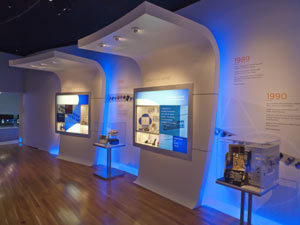
Qualcomm Museum Historical Timeline
At InfoComm 2011, PRO AV & ARCHITECT magazines and InfoComm International, the leading nonprofit association serving the professional AV communications industry worldwide, announced Nautilus Entertainment Design (NED) recipient of the Best Corporate AV Project in the fourth annual PRO AV Spotlight Awards for their work on Qualcomm 25th Anniversary Museum.
The awards were held June 16th at InfoComm 2011 in Orlando, Florida. Awards were given in fifteen categories for various types of A/V projects. A panel of PRO AV, ARCHITECT and ARCHITECTURAL LIGHTING editors, contributors and A/V systems integrators and consultants judged the entries.
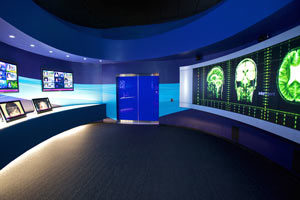
Qualcomm Museum curved video wall
NED provided lighting design and A/V system design for the Qualcomm Museum including over 16 large format interactive video kiosks and an integrated control system. The museum was designed to celebrate the 25 years of technological advancements of the company. Guests are invited to interactively explore the history as well as the future possibilities of Qualcomm technology.
The “Historical Timeline” display area contains what the team referred to as Wave Walls. Each of the eight Wave Walls was designed to house a combination of video tiles and Qualcomm historical artifacts. The highlight of the “Future Area” contains a flush mounted, curved video wall thirteen feet wide by four feet high.
2010
In this in-depth article, “L&SI Looks at Entertainment on the High Seas.” Jim Tetlow is interviewed as one of the key consultants for Carnival Cruises in the design and installation of entertainment systems for their ships. Please take a look.
Alan Edwards, principal audio designer at NED discusses his cruise ship work and his use of the SymNet DSP units. Please take a look.
Jim Tetlow and Nautilus Entertainment Design were mentioned in this article from Cast Software in their bi-monthly publication, “The Plan” regarding NED’s design work for the Costa Crociere. Please download.
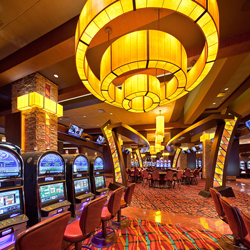
Choctaw Floor Monitors
SAN DIEGO, CA, March 4– With the grand opening of the Choctaw Casino Resort in Durant, OK on February 9th, a massive three-year project came to completion for the lighting and audio/video consulting firm Nautilus Entertainment Design (NED). NED was charged with all interior lighting and audio/video design including the installation supervision and commissioning of those components.
Owned and operated by the Choctaw Nation of Oklahoma, the resort is a much-needed addition to the very successful original casino resort. Designed by the architectural firm WorthGroup, NED worked closely with their Vice President of Design, Brian Hamlin to create elements that spoke of the Choctaw Nation and their relationship with their past but interpreted with a modern flair.
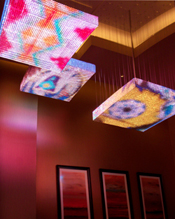
Choctaw LED chandeliers
For lighting, NED and the architectural firm designed close to 200 custom chandeliers and lighting features for the building. The most striking are three video chandeliers composed of 4 x 4 foot boxes containing LED panels. These chandeliers display video images through their crystal-encrusted exterior to set the mood and ambiance for the elevator lobby.
A hallmark of NED design is to give the owner great versatility with the lighting and audio/video systems. The Choctaw audio/video system allows employees the flexibility to select what video and/or audio feeds are appropriate at any time for their clientele. The digital signage system, consisting of 42 different channels of streaming content offers the ability to change feeds to any of the facility’s 190 displays. Guests can request their choice of program on any of the 24 video monitors located in the gambling table areas. Programming choices can also be made in the spa depending on the client’s mood. The most flexibility is offered in the Diamondback Cabaret Lounge. A live feed of the performance can be sent not only to the large side screen in the lounge, but also to the numerous monitors throughout the casino and ancillary spaces.
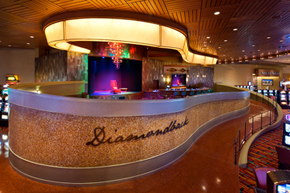
Choctaw Diamondback Lounge
An interesting challenge occurred concerning the architectural lighting of the gaming floor. “The casino ceiling consists of undulating tiles at various elevations designed to organically flow into wall structures. A wide variety of lighting fixtures and mounting techniques needed to be invented in order to place the lights where required,” commented Denis McCubbin, project manager/designer for NED.
NED is now in the planning stages with the WorthGroup for the renovation of the original Durant Choctaw casino that will include all lighting and audio/visual design services.
2009
SAN DIEGO, Calif., Jan. 14/ The North American International Auto Show (NAIAS) is the premiere event for the car manufacturers to show-off their new product models and generate a buzz for consumers. However, at NAIAS 2009 there is a necessary resolve to cut back on some of the extravagance from previous years. Nautilus Entertainment Design (NED) was again called upon by GM to light their press events and car displays. This year, Chrysler also requested their services to light their press event. Both looked to NED to cut cost but not production value or excitement.
“Certainly this is a tough period for the auto industry,” said Jim Tetlow, lead lighting designer. “We have been under a lot of pressure to do more with less money. However, these exhibits and press events are important for the manufacturers as they want the world to see their new products as they are proud of the new technology and innovations.”
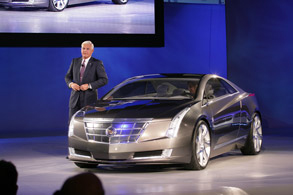 For GM’s first press event, it was a road rally and parade of vehicles driving the whole 400 foot length of the GM exhibit. GM employees lined the path with signs of support for their company as 17 current and future cars and crossovers drove past them to be presented on the turntables onstage. The staging was simple but elegant with multi-color lighting pools and a clean, sharp focus on the vehicles. GM kept their big surprise for last. The Cadillac Converj, a battery powered luxury concept car was the pièce de résistance of the event. The second GM press event was the announcement that GM will be building a new battery manufacturing facility in Michigan to provide the power systems for the Chevy Volt electric car and the future electric cars under development.
For GM’s first press event, it was a road rally and parade of vehicles driving the whole 400 foot length of the GM exhibit. GM employees lined the path with signs of support for their company as 17 current and future cars and crossovers drove past them to be presented on the turntables onstage. The staging was simple but elegant with multi-color lighting pools and a clean, sharp focus on the vehicles. GM kept their big surprise for last. The Cadillac Converj, a battery powered luxury concept car was the pièce de résistance of the event. The second GM press event was the announcement that GM will be building a new battery manufacturing facility in Michigan to provide the power systems for the Chevy Volt electric car and the future electric cars under development.
NED staff designer Kurt Doemelt was the onsite lighting director for the GM press events produced by C4 Communications of Birmingham, Michigan, with media content from Aquila Production from New York City.
This is the third year that NED has designed the lighting for the entire GM exhibit. With almost 100 vehicles on display, approximately 1,600 fixtures were used to cover the 112,400 sq. ft. area, twice the size of a football field. While there were extensive budget limitations for this year’s exhibit, GM made it clear that it was a high priority that the lighting of their cars and trucks should not be compromised. NED staff designer Don Hill and associate designer Tristan Gates designed the exhibit lighting.
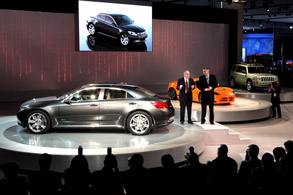 The Chrysler press event was also located inside their exhibit. A 90 foot wide scrim was the backdrop for the presentation. Behind the scrim were over 100 orange electric extension cords that were hung from the same truss as the scrim. These cords were side lit, independent of the scrim and provided a backdrop alluding to the new all electric products being introduced.
The Chrysler press event was also located inside their exhibit. A 90 foot wide scrim was the backdrop for the presentation. Behind the scrim were over 100 orange electric extension cords that were hung from the same truss as the scrim. These cords were side lit, independent of the scrim and provided a backdrop alluding to the new all electric products being introduced.
A total of three EV cars were introduced, two of which were revealed by silk covers being whisked away on cue to a flurry of strobe lights. Center stage, the Dodge Circuit EV was first revealed, followed on the right turntable by the Jeep Patriot EV, with finally the Chrysler 200C EV concept car was driven out onto the left turntable to loud applause.
This is the first time that NED has done the Detroit press events for Chrysler, but they have been doing many other press events and announcement shows for the car manufacturer since 1987. The production company was Kaleidoscope productions of New York and San Francisco, and the onsite lighting director was Patrick Schulz.
Immediately on the heels of the NAIAS, NED will be in quick turnaround as they make plans to light the thirteen events of the 2009 Presidential Inaugural Balls and Dinners. [Download Press Kit]
SAN DIEGO, Calif., Jan. 6/ Jim Tetlow and Nautilus Entertainment Design have been selected as lighting designers for the 2009 inaugural balls and candlelight dinners at the Presidential Inauguration in Washington, D.C.
The general service contractor for the events is Hargrove Inc. As part of the Hargrove technical team, Nautilus will be working with technical director Larry Estrin and sound designer Kelly Epperson. The project includes 13 events in 10 different locations around Washington, D.C.
Tetlow is a veteran when it comes to Presidential Inaugurations. Since 1981 he has been contracted for three previous induction festivities. This year is the second time he has served as principal lighting designer for all of the balls and dinners. This will be the sixth Inauguration for Larry Estrin.
2008
By Allan T. Duffin
“… The advantages of digital technology include “improved quality of audio and video, increased flexibility, and simplification of technical systems at the operator level,” says Jim Tetlow, owner and principal consultant of Nautilus Entertainment Design, Inc., in La Jolla, Calif. The company helps create lighting, audio, video and special effects systems for theatres and other entertainment facilities like cruise ships, Las Vegas hotels, and even the Senate and House chambers in the Capitol Building in Washington, D.C.” [Read the Article at the Dramabiz Magazine‘s Website]
SAN DIEGO, Calif., Dec. 16/ — Bombers, jet fighters, helicopters, missiles, a Mercury space capsule and other substantial artifacts are strategically placed throughout a museum the length of one and a half football fields. There is an installation schedule interrupted by a twenty-mile move from Stanton Island to

US Presidential Debate at Univ. Mississippi
Pier 86 in Midtown Manhattan. A hard deadline is set due to a week’s worth of special events attended by Presidents Bill Clinton and George W. Bush, military brass and celebrities. Those were a few of the challenges Nautilus Entertainment Design encountered when they were contracted to work with LightSource and Display Dynamics to provide lighting and control system designs for the refurbished Intrepid Sea-Air-Space Museum.
The Essex-class aircraft carrier of the United States Navy, the USS Intrepid was first launched in 1943, served in three wars as well as a recovery ship for the Mercury and Gemini space programs. The Intrepid, decommissioned in 1974, was opened in 1982 as a museum in New York City. Closed in 2006, it was first towed to Bayonne, New Jersey for 23 months of repair, then to Staten Island for refurbishment and finally back to its home at Pier 86 in October, 2008.
For Nautilus lighting designer Don Hill the biggest challenge was working within a hull that is over 60 years old.
“The Intrepid was refitted several times over the course of its active duty. One look at the ceiling of the hanger decks revealed a confusing mixture of old and new, active and inactive systems for HVAC, electrical, plumbing, etc,” stated Hill. “There were no reflected ceiling plans available so the work was based on our initial site survey, many emails and phone conversations and lots of dead reckoning during installation. Also considering the size of the exhibit space, approximately 48,000 sq. ft. extending the entire length of the ship, the guessing game was raised exponentially.”
To light the exhibits of aircraft and other artifacts, NED designed a pipe grid hanging on regular intervals throughout the space with a broad distribution of dimmable circuits ensures that the lighting can be readily adapted as exhibits are changed over time. A variety of conventional theatrical-style fixtures were used to be consistent with the museum’s existing inventory of ETC S4 Jrs, AR111 spot lights, PAR 38s and PAR 56s. The new dimmers are two ETC Sensor SR48 Dimmer Racks with dual 2.4k dimmer modules. They are used in conjunction with existing Strand and ETC Smartpack dimmers, all controlled with a Pharos lighting controller.
The 280-foot long exhibit display cases were a particular challenge. Sealed to protect artifacts from dust and moisture, the only access was in the removal of a 200-pound glass pane. To solve several problems, a conventional low-voltage track light system with high-output Bruck Ledra LED MR-16 lamps was used. The advantages were less heat, longer lamp life (35,000 hours versus halogens 2,000 hours) and no UV radiation which was perfect for lighting museum artifacts prone to fading or deterioration.
For Nautilus’s Brian Pratt, the designer of the master control system of all the museum elements, specifying an AMX system was the key in giving flexibility to the museum for straightforward ease-of-use while allowing ample expansion capability for the addition of exhibits in the future.
“The major challenges on this project were the large number of different systems and content providers and the very tight time-frame,” stated Pratt. “Flexibility and simplicity were required due to changes and refinements of other designers’ systems and the need for it to be operated by museum staff. With the flexibility of the AMX control system and great support from our installer and programmers at BlueWater Technologies, we were able to adapt to system changes as they occurred. Home Run Electric was great in getting the systems up and running which is no small task when working with wiring on a WWII aircraft carrier.”
The AMX system controls the ETC Pharos lighting control system, an Alcorn McBride Video Bin-loop (which provides all the video and audio playback on ten different LCD screens including two video projectors) sixty different relays and contactors which provides power and control to different interactive exhibit kiosks and displays, the audio system plus a show that runs every half-hour.
“The system allows the exhibition department to set up presets using a touch screen to individually pick and choose combinations of museum components to be in “on” or “off” mode and to set various lighting conditions,” Pratt continued. “This way they can set up the usual operational presets; open, cleaning, closed and for special events. The system also provides the ability to perform manual overrides so when a VIP is getting a tour of the museum, each show, exhibit or kiosk can be individually started just when the VIP arrives.”
The displays were by Display Dynamics (https://www.disdyn.com/ ) and the lighting and labor vendor was LightSource (https://www.lightsourceinc.com/ ). Download Press Kit
SAN DIEGO, CA, October 31 –The lighting of the 2008 Presidential and Vice-Presidential Debates proved to be another challenge-packed assignment for Jim Tetlow of Nautilus Entertainment Design with four different locations, three different staging formats and for the first time, the debates were broadcast in high-definition. Produced by the nonpartisan Commission on Presidential Debates, this is the third Presidential election in a row that Tetlow has been tapped as Lighting Designer.
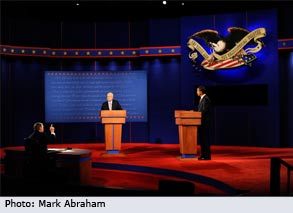
US Presidential Debate at Univ. Mississippi
All debate venues were located at universities chosen through a several year process by the Commission. The debates are typically staged in a field house or gymnasium; however the Ford Center for the Performing Arts at the University of Mississippi was the setting for this year’s first Presidential Debate. Although one would think that it would be easier to stage the debate in a theatre, this site proved to be a bigger challenge than the others due to the lack of rigging points over the apron and the audience.
“Ultimately, the debates are like classic ‘talking head’ interview shows, where you use portrait lighting for each speaker,” says Tetlow. “In a television studio, this typically means using some sort of soft fill light, whether they are halogen, fluorescent or LED sources. However, what makes the debates unique is creating portrait lighting from 55 feet way instead of the typical 8 to 10 feet in a broadcast studio. It’s the wide shot that defines the height and distance of the lighting fixtures and, in the case of the debates, that means a wide shot of the set, which was over 40 feet wide. To work at these long distances, ETC Source 4 ellipsoidals were used for the portrait lighting of the candidates and the moderator, while more general stage lighting for the candidate’s entrances was done with Arri 5Kw fresnels, and PAR 64s. The background of the candidates’ close-up shot was a lightbox of text from the Constitution.”
All of the venues had their own special challenges based on the debate formats—podium-style (where the candidates had lecterns as their home base), a town hall-style (that allowed the candidates to walk freely around the set and speak directly with the live studio audience), and a large interview-style desk (where the candidates and moderator were seated). “One of the advantages of portrait lighting,” Tetlow states, “is that it allows the lighting designer the flexibility to independently balance the lighting of each candidate, the moderator and the set.” This worked well for all of the debates except the “Town Hall” meeting, which was staged in the round. It was impossible to isolate the candidates as they continually moved around the stage and were surrounded by a live studio audience. The solution was to create an evenly illuminated, 360 degree environment in which the candidates could work comfortably.” Download Press Kit
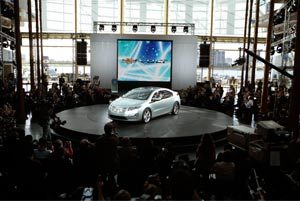
Chevy Volt Premiere
How do you light a televised car reveal for a sunny, daylight premiere when your only chance to focus and tech is during a dark and rainy rehearsal? That was the challenge for Jim Tetlow, of Nautilus Entertainment Design, as Lighting Designer of the much-anticipated Chevy Volt car premiere. The event took place in the 40,000 sq. ft. Wintergarden Atrium of the GM Renaissance Center in Detroit, Michigan, which features a full glass back wall and a transparent glass ceiling looking out on the Detroit River and the bright, morning sun.
On the morning of September 16, 2008, General Motors launched its next 100 years by unveiling the production version of the Chevrolet Volt, a vehicle that delivers up to 40 miles of gasoline-and emissions-free driving, with the extended-range capability of hundreds of additional miles. Introduced in a short speech by GM Chairman and CEO Rick Wagoner, the Volt was revealed when the video screen separated in half and General Motors Vice Chairman Bob Lutz drove the car downstage and onto a turntable to the standing ovation of employees, guests and press. The entire presentation was produced by the Detroit office of Jack Morton Worldwide.
Tetlow remarked that in addition to introducing a new vehicle and technology to the world it was also the celebration GM’s 100th anniversary and a glimpse of where the next century might take them. “This was definitely a moment of anticipation not only for GM but for all of Detroit and car enthusiasts everywhere,” Tetlow said. “This one-hour satellite telecast was fed live to GM facilities around the world and included live segments from GM facilities in six other countries. In addition to GM’s Wintergarden Atrium, the venue for the live event, we designed the lighting for three additional locations throughout the Renaissance Center.”
This one-hour event required a full week for load-in, installation and rehearsal. Lighting equipment for the reveal included 60 Vari*Lites®, a mixture of VL3500TM Spot and Wash Luminaires. The color balance and lighting levels were balanced for exterior daylight in anticipation of a sunny day. The design also had to balance to the “live” LED screen that was in many of the shots. Tetlow commented, “Unfortunately, we had dark and stormy weather for several days preceding the event. The lighting on the car and the executives looked fine in rehearsal, but in contrast everything else was dark. Fortunately, for the morning of the show we had a clear bright day and the lighting levels we had set on the stage balanced to the bright sunlight illuminating the background.” Download Press Kit
After designing entertainment systems for 26 cruise ships in the past 14 years, San Diego-based Nautilus Entertainment Design (NED) has recently completed work on three Carnival Corporation & plc ships within a few months of each other, providing designs as well as commissioning and inspection services for all entertainment and broadcast systems. [Read More… Download Press Kit
Cunard’s newest ocean liner, the Queen Victoria, is a massive ship that spans 12 expansive decks and boasts some of the most luxurious and modern facilities ever to sail the open seas. The magnificent liner features a multi-story grand lobby, numerous ambient restaurants, lounges, a casino and state-of-the-art theatres, many of which are equipped with self-powered Meyer Sound systems designed by San Diego-based Nautilus Entertainment Design . . . Read More…
Two Digidesign® VENUE live sound systems set sail recently on Cunard’s newest state-of-the-art international vessel, the Queen Victoria. The majestic ocean liner’s twelve decks are replete with some of the most luxurious and modern accoutrements on water, including a grand, multilevel lobby, casino, restaurants, and two theaters.
Nautilus Entertainment Design Inc. of San Diego provided the audio and video designs for the ship’s 30 individual entertainment venues, which range from intimate lounges, fitness centers, and recreational areas to the palatial Royal Court Theatre and Queens Room ballroom. Read More…
2007
The RSA Show was held in San Francisco at the Moscone Center on February 6th-9th …Read More…
2006
Looks are deceiving; this project looks like a permanent architectural installation, but it’s actually the Hewlett-Packard stand at ITU Hong Kong in December 2006. With approximately 9150 square feet of space, the ground floor housed an exhibit of HP products and technology, while upstairs had extensive conference rooms and a hospitality cafe. The design team opted for an approach that would make visitors feel they were in an actual architectural environment, not on a trade show floor. The conference rooms were generous; there were seven with seating capacity of 10 and three with capacity for six. The hospitality area seated over 40 people for refreshments. The space supported a fully functional kitchen, 17 reception desks, a VIP reception desk with coat check space and a fully integrated air conditioning system…Read More…
On June 30, Costa Concordia was delivered by Fincantieri at the Sestri Ponente shipyard in Genoa, Italy. Large in all senses, the Costa Concordia is 112,000 tons with total guest capacity of 3,780. She is the largest cruise ship in the Costa fleet – and the largest of any line operating in the Mediterranean… Read More…
2004
The presidential election kicked into high gear on September 29th with the start of the first presidential debate in Florida. NED’s TV lighting design veteran Jim Tetlow and his team Denis McCubbin and Kurt Doemelt were on hand to assure the venue was ready for the exacting standards of prime time viewing.
With only a handful of days between each scheduled debate, the production team was challenged with turning a convocation center at the University of Miami in Coral Gables, a gymnasium at Case Western Reserve University in Cleveland, an athletic complex at Washington University in Saint Louis and a Frank Lloyd Wright-designed theatre at Arizona State in Tempe, Arizona into four pristine television environments.
NED’s Jim Tetlow brings the extensive background in live-to-air television that producers have come to rely on. Tetlow lit the 2000 Presidential Debates, and has been a repeat designer for the Republican and Democratic Conventions over the last decade. He has also been responsible for lighting the NBC Broadcast Facilities at the Summer Olympics, Singapore’s Jubilee New Year’s show, and a wide variety of television specials, series, concerts and special events.
Archi-Tech magazine and the International Communications Industries Association named Nautilus Entertainment Design as a 2004 AV award winner for our work on Cunard’s Queen Mary 2 Illuminations Auditorium. NED provided entertainment facility design, including lighting, audio, video, rigging and special effects for over forty spaces on Queen Mary 2, the world’s largest passenger vessel. Queen Mary 2 gained immediate attention from the press and the public when Alstom Chantiers de l’Atlantique shipyard delivered the ship to Cunard in December of 2003 (see links below). NED’s project manager for the Queen Mary 2 local entertainment systems is Bill Havens, based in NED’s New York office. Queen Mary 2 will be followed in 2004 by Cunard’s Queen Victoria.
Cunard’s QM2 website
LiveDesign: “Smooth Sailing on the QM2”
Pre-2004
The premiere edition of Cruise Ship Interiors International features an article by NED’s Michael Lindauer about entertainment system technology on cruise ships.
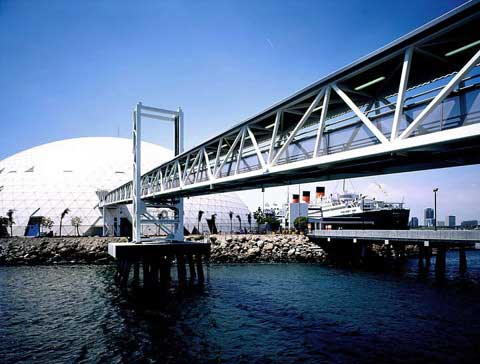 Nautilus Entertainment Design’s successful history of designing and commissioning entertainment systems for Carnival Corporation’s new cruise ships led Carnival to involve NED in the development of their first privately owned seaport, located in Long Beach, CA next to the historic Queen Mary and situated within the world’s largest geodesic dome. Carnival enlisted NED originally to design the local audio and video systems as well as a small Closed Circuit Television (CCTV) system to cover the needs of the Port Security force hired to monitor the facility. NED’s role was later expanded to include coordinating and designing the various security systems for the U.S. Immigration and Naturalization Services and U.S. Customs Services, now consolidated within the newly formed Department of Homeland Security.
Nautilus Entertainment Design’s successful history of designing and commissioning entertainment systems for Carnival Corporation’s new cruise ships led Carnival to involve NED in the development of their first privately owned seaport, located in Long Beach, CA next to the historic Queen Mary and situated within the world’s largest geodesic dome. Carnival enlisted NED originally to design the local audio and video systems as well as a small Closed Circuit Television (CCTV) system to cover the needs of the Port Security force hired to monitor the facility. NED’s role was later expanded to include coordinating and designing the various security systems for the U.S. Immigration and Naturalization Services and U.S. Customs Services, now consolidated within the newly formed Department of Homeland Security.
The inherent acoustical properties of working within a dome presented several design challenges for NED’s lead audio designer, Alan Edwards. “Our primary goal was to maximize intelligibility of the paging system, throughout the facility” says Edwards, “as well as provide a system that would sound good playing background music”. A combination of full-range column-array loudspeakers and digital signal processing provided the necessary components to achieve this goal. To accomplish the task of paging, a telephone interface with a digital message recorder was employed. This combination allows for flexibility of paging from any telephone location within the facility while the digital message recorders eliminate the possibility of feedback and allow for stacking of messages to eliminate page collisions.
In combination with the paging system, a series of forty-two inch plasma screens positioned in strategic locations around the facility provide passengers with critical information. Carnival’s internal Video Services department handled the video content while NED handled the technical design of the system and coordination of the installation and commissioning.
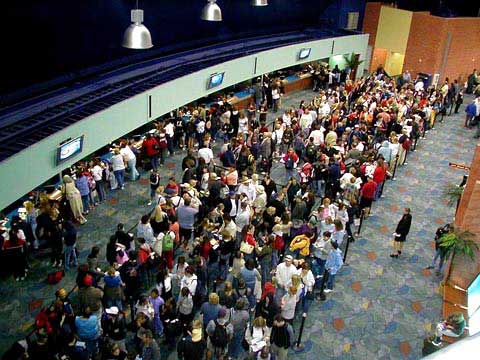 NED designed the CCTV systems, emergency Duress systems, intrusion detection systems and inter-agency visual alert and call systems to conform to the strict Post-911 regulations of the U.S. Immigration and Naturalization Services and the U.S. Customs Services. NED worked closely with Carnival, port security, and representatives of INS and Customs to develop a system which can be shared between the local security personnel and the government agencies. The resulting system consisted of a combination of 33 fixed and pan-tilt-zoom cameras, digital matrix, and digital recorder. Michael Lindauer who designed the CCTV systems says, “By creating 3 separate systems, one for Customs’ private areas, one for INS’ private areas, and one general system for all public spaces which can be shared by INS, Customs, and Port Security, we were able to keep the costs in line while providing all of the necessary functions.”
NED designed the CCTV systems, emergency Duress systems, intrusion detection systems and inter-agency visual alert and call systems to conform to the strict Post-911 regulations of the U.S. Immigration and Naturalization Services and the U.S. Customs Services. NED worked closely with Carnival, port security, and representatives of INS and Customs to develop a system which can be shared between the local security personnel and the government agencies. The resulting system consisted of a combination of 33 fixed and pan-tilt-zoom cameras, digital matrix, and digital recorder. Michael Lindauer who designed the CCTV systems says, “By creating 3 separate systems, one for Customs’ private areas, one for INS’ private areas, and one general system for all public spaces which can be shared by INS, Customs, and Port Security, we were able to keep the costs in line while providing all of the necessary functions.”
The terminal project culminated with the Carnival Ecstasy docking for the first time on April 15th to begin the facilities operation. Currently, Carnival plans to make this the home port for two ships, the Carnival Ecstasy and Carnival Elation, both of which operate 3, 4, and 7 day cruises to the Mexican Riviera.
NED earned a 2003 Electrical Excellence Award from the Los Angeles County chapter of the National Electrical Contractors Association for work on the cruise terminal.
The team at Nautilus Entertainment Design completed the entertainment facility designs for five luxury cruise ships in 2003. July saw the birth of a new Carnival Conquest-class ship, the Carnival Glory. At 952.1 feet in length, this “stretched” vessel is the second of the Conquest class and 60 feet longer than her sister ships, the Carnival Destiny, Carnival Triumph and Carnival Victory.
Color is a central design theme aboard Carnival Glory, with each public room celebrating a different shade of the rainbow. Old Glory, the main atrium, features paintings of U.S. flags, and colorful rooms from history have inspired some of the other decor on board. For example, the Platinum and Golden Dining Rooms are designed after the famous Silver and Golden Temples in Kyoto, Japan.
Carnival Glory boasts a fully outfitted three-deck 1400-seat main theatre, with a four-deck-high stage house. Called the Amber Palace, the theatre is named after Russia’s famous Amber Room, a gift by Frederick the First of Prussia to Peter the Great in 1715. The theatre is complete with a versatile audio system, including surround-sound, and an extensive lighting system using the latest Ethernet-based DMX distribution and moving light fixtures. Also included is a full-height automated scenery fly system with 25 motorized line sets, an eight meter diameter turntable with an integrated step unit, and a motorized orchestra pit with rolling bandwagon.
NED coordinated the designs and commissioning of the main lounge systems, as well as entertainment systems for 26 other public spaces including lounges, bars and clubs, the health spa, corporate meeting rooms, children’s areas, and crew areas.
In keeping with the colorful theme of the ship, Carnival Glory’s interior design incorporated extensive LED backlit ceilings on the main public deck. Envisioned by interior design architect Joe Farcus, these aluminum and plexiglass ceiling panels were backed with lengths of red, green and blue LED strips, which provided continuously changing kaleidoscopic effects. HMS Italy engineered and built the ceiling panels, with NED coordinating on behalf of the architect and owner. Due to the large number of control channels required, the system was controlled with 3 separate Whole Hog PC controllers.
HMS Italy engaged Prelite New York to model the entire system with WYSIWYG pre-visualization software prior to commissioning. NED’s Michael Lindauer explains, “Prelite NY worked in their studio, producing videos for each of the areas programmed, which were sent to the architect in advance. The architect was able to approve the programming well before the system was completed, significantly reducing the number of man-days required for on-site programming. Prelite’s Rodd McLaughlin flew to Italy for just two days of touch-up programming – which were mostly timing changes.”
The “kaleidoscopic” theme was extended into the three-deck-tall main atrium wall. NED investigated several options for projection to fulfill the architect’s concept of “light that creates a giant abstract painting that will never look exactly the same . . .” For a number of reasons including size, lamp life, and simplicity of operation, NED chose the Optikinetics GoboPRO projectors with liquid oil effects wheels on rotators. NED commissioned the completed system, and supervised the focusing and programming of the projectors.
In total, NED was responsible for the specification and commissioning of entertainment systems for 27 areas on the ship, the programming of the public area house lighting and specialty house lighting, and the commissioning of the broadcast center systems.
The October 2002 issue of PLSN featured an interview with Jim Tetlow about his career and the development of Nautilus Entertainment Design. Jim was interviewed by PLSN again for an article about lighting design on board cruise ships for the May 2003 issue.
Entertainment Design magazine published an article by NED consultant Alan Edwards in the May 2004 issue. The article explains the unique challenges that cruise ship venues present to audio designers. NED consultant Michael Lindauer contributed to the June 2002 issue of Entertainment Design, writing an article discussing rigging systems for cruise ships. That issue also included an interview with NED’s Jim Tetlow about entertainment facility design for cruise ships. The articles are available from Entertainment Design’s webpage by following the links below.
LiveDesign: “Designing Flexible Audio Systems For Cruise Ships” by Alan Edwards
LiveDesign: “Cruise Ship Technology: When Down Isn’t Down” by Michael Lindauer
Live Design: “A Q&A With Cruise Ship Guru Jim Tetlow” by Ellen Lampert-Gréaux
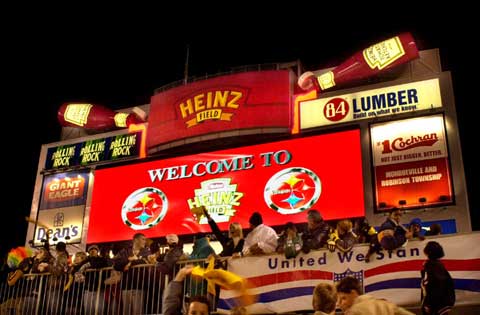 Nautilus Entertainment Design (NED) has met many interesting challenges over the years, but the one presented by Heinz was red hot! In June of 2002, the H.J. Heinz Company and the Pittsburgh Steelers announced a 20-year partnership to name their new stadium “Heinz Field.” This 65,000-seat venue replaces Three Rivers Stadium and is the new home of the Pittsburgh Steelers and University of Pittsburgh Panthers. The agreement gives Heinz an exclusive platform to promote its brand and products to millions of football fans around the world, according to William R. Johnson, Heinz Chairman, President, and CEO.
Nautilus Entertainment Design (NED) has met many interesting challenges over the years, but the one presented by Heinz was red hot! In June of 2002, the H.J. Heinz Company and the Pittsburgh Steelers announced a 20-year partnership to name their new stadium “Heinz Field.” This 65,000-seat venue replaces Three Rivers Stadium and is the new home of the Pittsburgh Steelers and University of Pittsburgh Panthers. The agreement gives Heinz an exclusive platform to promote its brand and products to millions of football fans around the world, according to William R. Johnson, Heinz Chairman, President, and CEO.
To establish their identity in the new stadium, Heinz wanted to use a unique, identifiable icon – specifically their classic ketchup bottle – which is recognized worldwide. Eager to make a definitive statement, Heinz marketers developed the concept of forcing the competition to play “ketch-up football”. A variety of different arrangements, sizes and materials were considered during the design process, including an LED display in the shape of a 3D ketchup bottle.
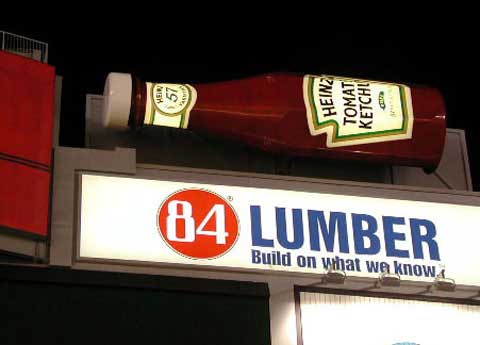 The final decision was to create two semi-3D photo-realistic structures – 35′ long, 9′ high and 6′ deep – in the shape of Heinz ketchup bottles. These devices, which weigh several tons each, sit atop the Sony Jumbotron scoreboards inside the stadium. When the Steelers or Panthers get within the “Heinz Red Zone,” otherwise known as the area between the 20-yard line and the goal line, the bottles will tilt downward, the caps will flip up and ketchup will flow downward toward the scoreboard, starting an animation sequence on the Jumbotrons. This is to urge the home team to “pour on” the points. They may also be used when a touchdown is made.
The final decision was to create two semi-3D photo-realistic structures – 35′ long, 9′ high and 6′ deep – in the shape of Heinz ketchup bottles. These devices, which weigh several tons each, sit atop the Sony Jumbotron scoreboards inside the stadium. When the Steelers or Panthers get within the “Heinz Red Zone,” otherwise known as the area between the 20-yard line and the goal line, the bottles will tilt downward, the caps will flip up and ketchup will flow downward toward the scoreboard, starting an animation sequence on the Jumbotrons. This is to urge the home team to “pour on” the points. They may also be used when a touchdown is made.
NED was contracted to design the structures and manage the project from the construction through the installation of the signs. The company became involved very early in the design process, developing a number of different options at the request of Heinz. Their 3D drafting and rendering capabilities allowed them to rapidly generate images of the various possibilities and provide views from different locations around the stadium, which was highly valuable because the time frame to design, construct, install and program these devices was very short. One of the requirements established by Heinz was that the bottles should appear completely realistic, yet animated at certain times during the football games. To accomplish this, the bottles are fabricated of red tinted fiberglass resin and internally illuminated with red neon. There are cutouts for the white labels, which are actually light boxes. When tilted, the mouths of the bottles are aligned with LED panels mounted on the face of the scoreboard leading to the Jumbotron displays. The LED panels are programmed to simulate the ketchup pouring out of the bottle and down to the Jumbotron, which then displays additional animation of the entire Jumbotron filling with Heinz ketchup.
Young Electric Sign Company of Las Vegas (YESCO), a company well known for many of the Las Vegas casino signs, constructed the signs for the field.
The new icons were seen by the public for the first time on the Monday night football game on October 29th, 2002, broadcast by ABC.
The NED office in New York provided the project management, while the research, design and drawing packages were created at NED’s home office, located in La Jolla, California. The NED project manager was Bill Havens, who shared the onsite installation supervision with Denis McCubbin. The NED staff provided 3D renderings by Carrie Sefcik.
Michael Doherty, general manager of communications at Heinz Frozen Food Company, who was the company’s coordinator for the new stadium commented: “Nautilus was selected to design and manage this project based on their track record and their unique abilities to integrate all of the various technologies that were required on a very tight schedule. Their 3D design capabilities allowed everyone involved to visualize the final product at the very beginning of the design, putting everyone on the same page on a project that could not afford any delays.”
